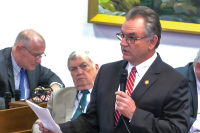Ivory-billed hiatus
Ornithologists Geoff Hill of Auburn University and Dan Mennill from University of Windsor presented a program at this year’s American Ornithological Union’s meeting in Veracruz, Mexico on Oct. 4, regarding their claims of the presence of the ivory-billed woodpecker in Florida.
The pair plus three of their graduate students recently published a paper in the new Canadian online journal Avian Conservation and Ecology. The article can be found here http://www.ace-eco.org/vol1/iss3/art2/. Hill and Mennill also both have websites regarding their findings Hill’s is here, http://www.auburn.edu/academic/science_math/ cosam/departments/biology/faculty/webpages/hill/ivorybill/index.html, and Mennill’s here, http://web2.uwindsor.ca/courses/biology/dmennill/index.html.
The evidence basically consists of several brief sightings of supposed ivory-billeds flying away and some culled (from 11,500 hours of recording) recordings that the researchers believe were ivory-billed double raps and “kent” calls — still no definitive proof.
While the evidence is generally more of the same kind of stuff posited by Cornell Lab of Ornithology as evidence of an ivory-billed along the Cache River in Arkansas back in 2004, there is a slight twist. Hill claims to have seen the bird. I am not 100 percent sure, but I believe his claims are the first by any ornithologist regarding ivory-billeds in the States since John Dennis back in the ‘60s. Dennis was never able to corroborate his sighting.
While I remain highly skeptical of the continued existence of the ivory-billed in the US and personally convinced that neither Cornell nor Auburn have provided definitive evidence, I am going to take an ivory-billed hiatus until after this year’s “search season” — unless, of course, that million dollar photo should appear.
Besides continued searches in Arkansas and Florida, there will be searches in South Carolina, Louisiana, Texas and perhaps other southern states. If, as I suspect, that million-dollar photo is still absent after this search season, I would hope that researchers would sit down and reassess their findings objectively.
Related Items
I would dearly love to know that the ivory-billed was still with us, but I see no compelling evidence that it is. I think science has been co-opted with regards to the ivory-billed. I believe ego, conservation interests, notoriety and the overwhelming desire to see ivory-billeds in the wild have taken precedence over sound scientific inquiry.
But Hill said he saw one and he knows it’s there. I think back to my college days and trips to the Louisiana Gulf Coast during spring migration with my ornithology professor. Man, was he good.
A couple of years ago I had the pleasure of birding with Fred Alsop, field guide author and ornithologist at East Tennessee State University. And man was he good. So when an ornithologist says “I saw the bird and I’m gonna get a photo,” I’m ready to pause and let him do it.
Readers can keep up with the ivory-billed saga via the Internet. There are unlimited Web and blog sites. A simple Google search for ivory-billed will overwhelm you. With this new Florida announcement, the blogs are presently on sensory overload and are getting kind of testy. There’s a lot of sniping back and forth between ivory-billed believers and skeptics, but I still highly recommend Tom Nelson’s ivory-bill skeptic blog - http://tomnelson.blogspot.com/. Nelson keeps his finger on the pulse of ivory-billed happenings and although his blog is from a decidedly skeptical point of view he always links to whatever it is he is discussing so the reader can get both sides of the story.
So, unless that smoking gun is uncovered I will not bore you with any more of my personal ivory-billed rants till May 2007. You don’t have to look so happy!









